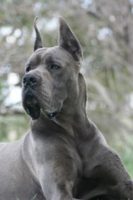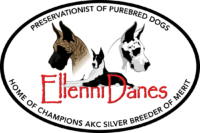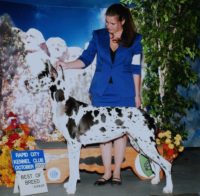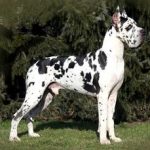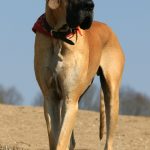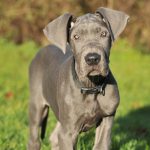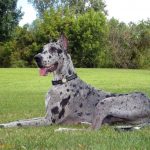 Great Danes, being such large dogs, require special care from their owners. To provide the best Great Dane care you should be knowledgeable about how diet, exercise and healthcare conditions can affect them.
Great Danes, being such large dogs, require special care from their owners. To provide the best Great Dane care you should be knowledgeable about how diet, exercise and healthcare conditions can affect them.
Feeding Your Great Dane
A growing Great Dane needs plenty of food. Bitches aged between three and six months will need three to six cups of high quality dog food, and a male dog will need between four and eight cups. An adequate diet is extremely important to provide the best Great Dane care.
Between eight months and one year, a bitch will need five to eight cups per day, and a male dog six to 10 cups.
Adolescent bitches will require eight cups of food, and male dogs between 9 and 15. Then, when fully grown, bitches can stay on eight cups, and makes will need between eight and 10 cups.
Great Danes under the age of five months should be fed three times per day, and over five months, it can be reduced to two meals per day. Some breeds of dog are fine with just one meal per day, but Great Danes are too large for just one daily meal.
Great Dane Care: Grooming Your Great Dane
Great Danes might have short hair, but they do shed a lot, and throughout the year. Regular brushing of the coat will reduce the amount of hair that is shed. This is more ideal for those who keep their Great Dane in the home. To keep the hair shedding at bay, use a firm bristled brush and shampoo on the hair, dry, when necessary. That will keep your Great Dane’s coat healthy and clean. This will reduce the amount you’ll need to bathe your Great Dane, which is by no means an easy task.
As well as maintaining a healthy coat, owners should also be sure to brush their dog’s teeth at least two or three times a week. This stops tartar from building up around the teeth and causing bacteria to grow and cause gum disease.
Trimming Your Great Dane’s Nails
Trimming your dog’s nails is less frequent, but should still be done once or twice a month if they don’t get worn down naturally from their regular walking. The nails may not wear down as quickly if you walk mostly on soft ground.
You can see where you should trim your dogs nails by checking the color. You can see the blood vessels in the dog’s nails as they appear red. The rest of the nail is white, and it’s this part that you should trim. Make sure you’re careful not to go past the blood vessel, as this can cause bleeding and pain.
Check your dog’s ears regularly, too. If they look dirty use a damp cotton ball and gently clean the inside. Instead of water, you can also use a PH-balanced ear cleaning solution designed for dogs. This will help prevent your pet from developing ear infections.
Understand Common Great Dane Care Problems
Great Danes are prone to a number of health problems, and owners should be aware of them so that they can take steps to reduce the pain and effects of these conditions. The large dog has long extremities, so its easier for them to cold cold in the winter. If your Great Dane is an outdoor dog, you should bring them in for the winter – and when they go out walking, find them a fleece coat them can keep them warm. Their short fur doesn’t do much to keep them warm outdoors.
The large legs can also be affected by hip dysplasia. This is where the hip bones to not properly accommodate the thighbone, meaning they can come out of place and cause severe pain. This can get worse as the dog gets older. It’s important to visit a veterinarian if your dog begins to exhibit signs of pain.
Arthritis is also quite common in Great Danes, and gets worse as the dog gets older.
Beyond bones, Great Danes are also prone to gastric torsion, which is also known as ‘bloat’. This condition can be life threatening, and it is more likely to affect your dog if you feed them just one large meal per day. The reason why it is not advised to feed large dogs once a day is that the dog may eat rapidly and drug large amounts of water after they eat, which caused bloat and stomach discomfort. It happens when the stomach becomes distended with air, and then begins to twist. This ultimately causes the dog to dry heave and vomit, and as the stomach remains twisted, less blood is pumped through the heart and blood pressure drops dramatically.
Great Dane Bone Cancer
Even more seriously, bone cancer can sometimes occur in Great Danes. This is also known as osteosarcoma, and it’s the most common form of bone cancer that is found in dogs, but it tends to occur more in large dogs like the Great Dane. This breed also develops the cancer at much younger ages. The first sign that your dog is suffering from bone cancer is struggling walking and using their legs. Be vigilant for these symptoms to provide the best Great Dane care. Take your dog to the vets and they will perform an X Ray to confirm the problem and discuss options for treatment.
Maintaining a healthy diet is so important for your dog, as it can also help reduce the chance of your Great Dane suffering from heart disease. This is common in older Great Danes and the chances of it being developed can be reduced with plenty of exercise and healthy, high quality dog food.
